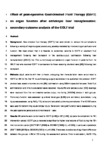Effect of post-operative goal-directed fluid therapy (GDFT) on organ function after orthotopic liver transplantation: Secondary outcome analysis of the COLT randomised control trial
| dc.contributor.author | Froghi, F | |
| dc.contributor.author | Gopalan, V | |
| dc.contributor.author | Anastasiou, Z | |
| dc.contributor.author | Koti, R | |
| dc.contributor.author | Gurusamy, K | |
| dc.contributor.author | Eastgate, C | |
| dc.contributor.author | McNeil, M | |
| dc.contributor.author | Filipe, H | |
| dc.contributor.author | Pinto, M | |
| dc.contributor.author | Singh, J | |
| dc.contributor.author | Longworth, L | |
| dc.contributor.author | Mallett, S | |
| dc.contributor.author | Schofield, N | |
| dc.contributor.author | Thorburn, D | |
| dc.contributor.author | Martin, Daniel | |
| dc.contributor.author | Davidson, BR | |
| dc.date.accessioned | 2022-04-28T12:30:15Z | |
| dc.date.issued | 2022-03 | |
| dc.identifier.issn | 1743-9159 | |
| dc.identifier.issn | 1743-9159 | |
| dc.identifier.other | 106265 | |
| dc.identifier.uri | http://hdl.handle.net/10026.1/19101 | |
| dc.description.abstract |
BACKGROUND: Goal-directed fluid therapy (GDFT) has been shown to reduce the complications following a variety of major surgical procedures, possibly mediated by improved organ perfusion and function. We have shown that it is feasible to randomise patients to GDFT or standard fluid management following liver transplant in the cardiac-output optimisation following liver transplantation (COLT) trial. The current study compares end organ function in patients from the COLT trial who received GDFT in comparison to those receiving standard care (SC) following liver transplant. METHODS: Adult patients with liver cirrhosis undergoing liver transplantation were randomised to GDFT or SC for the first 12 h following surgery as detailed in a published trial protocol. GDFT protocol was based on stroke volume (SV) optimisation using 250 ml crystalloid boluses. Total fluid administration and time to extubation were recorded. Hourly SV and cardiac output (CO) readings were recorded from the non-invasive cardiac output monitoring (NICOM) device in both groups. Pulmonary function was assessed by arterial blood gas (ABG) and ventilatory parameters. Lung injury was assessed using PaO2:FiO2 ratios and calculated pulmonary compliance. The KDIGO score was used for determining acute kidney injury. Renal and liver graft function were assessed during the post-operative period and at 3 months and 1-year. RESULTS: 60 patients were randomised to GDFT (n = 30) or SC (n = 30). All patients completed the 12 h intervention period. GDFT group received a significantly higher total volume of fluid during the 12 h trial intervention period (GDFT 5317 (2335) vs. SC 3807 (1345) ml, p = 0.003); in particular crystalloids (GDFT 3968 (2073) vs. SC 2510 (1027) ml, p = 0.002). There was no evidence of significant difference between the groups in SV or CO during the assessment periods. Time to extubation, PaO2: FIO2 ratios, pulmonary compliance, ventilatory or blood gas measurements were similar in both groups. There was a significant rise in serum creatinine from baseline (77 μmol/L) compared to first (87 μmol/L, p = 0.039) and second (107 μmol/L, p = 0.001) post-operative days. There was no difference between GDFT and SC in the highest KDIGO scores for the first 7 days post-LT. At 1-year follow-up, there was no difference in need for renal replacement therapy or graft function. CONCLUSIONS: In this randomised trial of fluid therapy post liver transplant, GDFT was associated with an increased volume of crystalloids administered but did not alter early post-operative pulmonary or renal function when compared with standard care. | |
| dc.format.extent | 106265-106265 | |
| dc.format.medium | Print-Electronic | |
| dc.language | en | |
| dc.language.iso | eng | |
| dc.publisher | Elsevier | |
| dc.subject | Adult | |
| dc.subject | Cardiac Output | |
| dc.subject | Fluid Therapy | |
| dc.subject | Goals | |
| dc.subject | Humans | |
| dc.subject | Liver Transplantation | |
| dc.subject | Prospective Studies | |
| dc.title | Effect of post-operative goal-directed fluid therapy (GDFT) on organ function after orthotopic liver transplantation: Secondary outcome analysis of the COLT randomised control trial | |
| dc.type | journal-article | |
| dc.type | Journal Article | |
| dc.type | Randomized Controlled Trial | |
| plymouth.author-url | https://www.webofscience.com/api/gateway?GWVersion=2&SrcApp=PARTNER_APP&SrcAuth=LinksAMR&KeyUT=WOS:000860453400015&DestLinkType=FullRecord&DestApp=ALL_WOS&UsrCustomerID=11bb513d99f797142bcfeffcc58ea008 | |
| plymouth.volume | 99 | |
| plymouth.publication-status | Published | |
| plymouth.journal | International Journal of Surgery | |
| dc.identifier.doi | 10.1016/j.ijsu.2022.106265 | |
| plymouth.organisational-group | /Plymouth | |
| plymouth.organisational-group | /Plymouth/Faculty of Health | |
| plymouth.organisational-group | /Plymouth/Faculty of Health/Peninsula Medical School | |
| plymouth.organisational-group | /Plymouth/REF 2021 Researchers by UoA | |
| plymouth.organisational-group | /Plymouth/REF 2021 Researchers by UoA/UoA01 Clinical Medicine | |
| plymouth.organisational-group | /Plymouth/Users by role | |
| plymouth.organisational-group | /Plymouth/Users by role/Academics | |
| dc.publisher.place | United States | |
| dcterms.dateAccepted | 2022-02-09 | |
| dc.rights.embargodate | 2023-2-17 | |
| dc.identifier.eissn | 1743-9159 | |
| dc.rights.embargoperiod | Not known | |
| rioxxterms.versionofrecord | 10.1016/j.ijsu.2022.106265 | |
| rioxxterms.licenseref.uri | http://www.rioxx.net/licenses/all-rights-reserved | |
| rioxxterms.licenseref.startdate | 2022-03 | |
| rioxxterms.type | Journal Article/Review |


